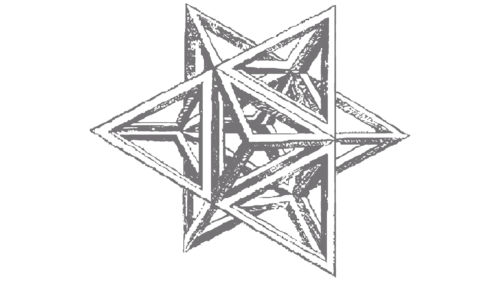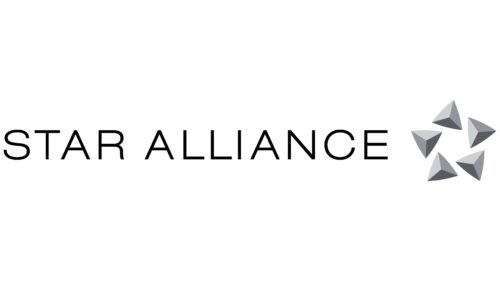The Star Alliance logo features faceted stones swirling in a mesmerizing dance. The symbol speaks of grace, solidarity, and the coordinated work of the system. Each union member is strong and reliable, and their alliance provides comfort and protection to passengers.
Star Alliance: Brand overview
Star Alliance is the very first and largest airline alliance in the world. It counts 26 members, the last of which joined in 2014. The group has a fleet of 5,000 airplanes, flying to 1294 destinations on all continents and many islands. Up to 800 million passengers pass through the alliance’s airports each year.
On May 14, 1997, five major airlines—United Airlines, Lufthansa, Air Canada, SAS, and Thai Airways International—officially established Star Alliance. This alliance marked a revolutionary step in the aviation industry, aiming to enhance passenger service and operational efficiency. The vision was to offer travelers seamless global connectivity through the combined networks of all member airlines.
By 1999, the alliance experienced significant growth, welcoming Ansett Australia, Air New Zealand, and All Nippon Airways (ANA) into its fold. This expansion bolstered its presence in the Asia-Pacific region, solidifying its position as a leading global network.
In 2000, the group continued its expansion and introduced Austrian Airlines, Singapore Airlines, and BMI (British Midland). This year saw the introduction of the “Move Under One Roof” concept, which aimed to consolidate member airline operations in shared terminals at key airports, streamlining the passenger transfer process.
In 2003, despite industry challenges post-9/11, the alliance persisted in its growth trajectory. Asiana Airlines, Spanair, and LOT Polish Airlines joined, further strengthening the footprint in Asia and Europe.
By 2006, the “Star Alliance Gold” program was launched, providing enhanced privileges for frequent flyers across all member airlines. This initiative significantly increased the appeal to business travelers.
In 2008, the global reach extended further, including Turkish Airlines and Egypt Air. This year marked the alliance’s tenth anniversary, reinforcing its status as the world’s largest airline network.
By 2010, the group introduced the “Common IT Platform” (CITP), which aimed to improve the integration of IT systems among member airlines. This advancement streamlined booking and check-in processes for passengers flying on multiple member airlines.
In 2012, the presence in Latin America expanded by adding Avianca, TACA Airlines, and Copa Airlines. This growth opened new opportunities for travelers in this region.
By 2014, various initiatives were launched to enhance the passenger experience, including self-service baggage check-in and improved transfer processes at key hubs.
In 2016, the alliance embarked on a digital transformation journey, focusing on enhancing online services and mobile applications for travelers.
2017, the group celebrated its 20th anniversary, reaffirming its position as a pioneer and leader among global airline alliances. By this time, the network had grown to include 28 member airlines, serving over 1,300 airports in 191 countries.
From 2018 to 2019, the focus intensified on sustainability and environmental responsibility, with several initiatives launched to reduce the environmental impact of air travel.
In 2020, faced with unprecedented challenges in the aviation industry, the group focused on supporting its members and adapting to the new realities of the air travel market.
Meaning and History
The Star Alliance symbol did not appear right away. At the beginning of the union, only a common figure was used, which was convenient to add to the fuselage next to the individual logo of each company. When the union grew, the alliance ordered developing a more stylish sign suitable for the 21st century. The basis for the logo is a circle of stars, symbolizing unity and harmony on flags. However, more impressive and monumental figures have replaced the celestial bodies. The resulting emblem has represented the Star Alliance for over 20 years.
What is Star Alliance?
An alliance of airline companies that operates worldwide and makes more than 20 thousand flights daily. Over 400 thousand pilots work on the planes of the member companies. Regular customers are offered privileges at the Star Silver and Gold levels. The headquarters is in Germany, based on one of the alliance members in Frankfurt-am-Main.
1997 – 2000
The first emblem of the alliance is a geometric figure made up of separate pyramids, which together form two large pyramids piercing each other. The resulting construction resembles a volumetric star, with rays spreading in different directions.
The beauty of the sign is caused by the correctness of proportions and the clarity of lines. Mathematics and geometry are needed to create the emblem. The star indicates:
- Precise routes, calculations for determining coordinates, and laying the course.
- Blueprints. Each airplane is a pinnacle of engineering thought. Its proper construction, sufficient engine power, and streamlined body allow it to take to the sky. A miscalculation is an inevitable disaster.
- Coordinated work. All members of the alliance adhere to one statute. Intersecting routes are formed within the system. Careful planning and alignment of flights help travelers with transfers reach any corner of the world.
The pyramid image is associated with the sky and flights. Each structure stretches upward, and the sloping sides are like runways directing the airplane upward. Each peak is a major city on Earth. Straight lines run between them. This technique conveys the alliance’s main goal—to connect all the planet’s megacities with air routes.
Each small pyramid in the logo is a separate member of the community. Occupying their allotted positions, the group forms a single whole, a precise and coordinated mechanism.
2000 – today
2000, the Alliance Management Team was formed, and the first business centers were opened. Structuring and overall management required a separate identity for the alliance. The Pentagram agency developed the famous sign.
The logo consists of a name and a circular figure. Thin uppercase letters Star Alliance are a model of lightness and airiness. Each line hints at a separate sky route.
The figure is composed of five separate pyramids arranged in a circle. Each is half-turned with one of its faces inward. The construction resembles a flower. Five peaks are like the rays of a star.
The pyramids correspond to the five founding companies:
- United Airlines (the third largest carrier in the world from Chicago).
- Scandinavian Airlines (common airlines of Denmark, Norway, and Sweden, owning 180 aircraft).
- Thai Airways International (Thai carrier with 40 international flights).
- Air Canada (a major Canadian company that serves 222 destinations).
- Lufthansa (the second largest airline in Europe from Germany).
Pyramids were chosen because of their uniqueness, stability, and geometric perfection. The base of each figure is unshakeable, indicating the strength of the alliance and the confident position of individual firms. The lines of the figures are not straight but slightly rounded, which speaks of the beauty and harmony of the heavenly fleet.
Font and Colors
Black and metallic gray are the emblem’s leading shades. Dark colors reflect the alliance’s monumentality and globality. Metal is the main element of airplane bodies. In the emblem, the color is a prototype of the union’s strength and transportation safety. Shadows on the edges of the pyramids make them volumetric. They discuss the various advantages passengers receive when using the alliance’s services.
The font corresponds to Neue Helvetica Paneuropean with large but thin elements.






